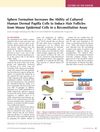TLDR Collagen gel contraction in hair follicle culture is mainly influenced by the amounts of collagen, dermal papilla cells, and epithelium cells.
The study identified that the primary factors affecting collagen gel contraction in hair follicle organotypic culture were the concentrations of rat tail collagen, hair follicle dermal papilla cells, and hair follicle epithelium cells. These components played a crucial role in the contraction process, suggesting that manipulating their concentrations could influence the outcomes of hair follicle culture experiments.
 1 citations
,
February 2017 in “Dermatologic Surgery”
1 citations
,
February 2017 in “Dermatologic Surgery” The basement membrane matrix helps rebuild hair follicles faster and more effectively.
January 2014 in “Journal of Tissue Engineering and Reconstructive Surgery” Rabbit hair follicle stem cells and nano silk fibers can create a tissue-engineered urethra.
 51 citations
,
August 2013 in “Journal of Investigative Dermatology”
51 citations
,
August 2013 in “Journal of Investigative Dermatology” Human skin cells can create new hair follicles when transplanted into mice.
 75 citations
,
August 2011 in “Journal of Investigative Dermatology”
75 citations
,
August 2011 in “Journal of Investigative Dermatology” Forming spheres boosts the ability of certain human cells to create hair follicles when mixed with mouse skin cells.
30 citations
,
July 1998 in “British Journal of Dermatology” Fat cells slow hair cell growth but speed up their development.
45 citations
,
May 1992 in “Journal of Investigative Dermatology” 6 citations
,
January 1990 in “The Journal of Dermatology” Human hair follicle cells can be grown successfully on floating collagen membranes without extra support.
87 citations
,
October 1987 in “Journal of Investigative Dermatology” 106 citations
,
April 1986 in “British Journal of Dermatology” Dermal papilla cells from human hair follicles form unique structures and don't live as long as other skin cells in lab conditions.


